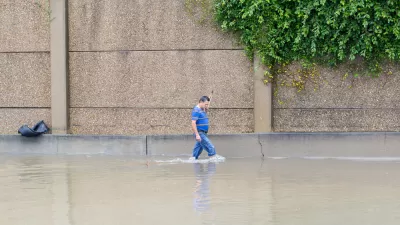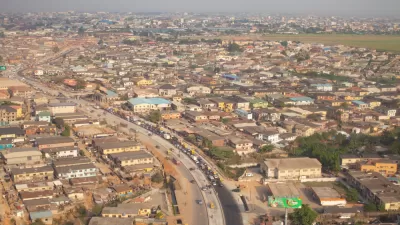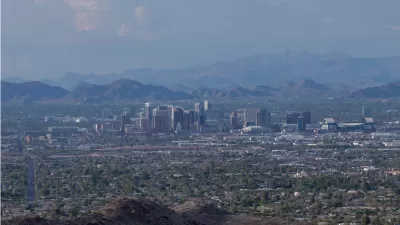Insight into the hard work of implementing the New Urban Agenda.

It's been over a year now since all 193 countries of the United Nations adopted by acclamation the "New Urban Agenda," the outcome document of the Habitat III conference held in October 2016. The historic nature of that achievement is hard to over-state: for the first time, we have a world-wide agreement embracing walkable mixed use, mixed transportation modes, polycentric regions, diversity and affordability, and other elements of a "new urbanism" (by any other name).
But now comes the hard part of implementation. That challenge was the focus of the Ninth World Urban Forum in Kuala Lumpur in early February of 2018—the first since the adoption of the New Urban Agenda, and the first to take up the specifics of implementation.
The obstacles are daunting. "Business as usual"—especially sprawl—still dominates in too many places. Yet there is considerable good news about the human benefits of urbanization: improvements in health and well-being, more opportunities for women, moderated population growth, better access to services, better resources for human development and cultural growth, and much more.
Those benefits don't come equally to all, of course, and that is one of the biggest challenges: creating a form of urbanization that is more equitable, and more effective in delivering on the great promises of cities for all. Of course that is the core reason that so many of us are drawn to cities and towns in the first place. That was, in fact, the theme of the conference: "Cities for All: Implementing the New Urban Agenda."
So for one week in early February, 25,000 participants from all 193 countries gathered in Kuala Lumpur and took up those challenges, forging partnerships and developing pilot projects. I noted five key takeaways from the conference:
1. The world is urbanizing at a blistering pace.
At present rates—and there's currently no sign this will change—the world's urban population will more than double in the next 40 years. That's a staggering rate and quantity of urbanization. Essentially we will create more urban fabric than has ever been created in all of human history up to now.
2. Much of this urbanization is sprawling and resource-inefficient.
While the number of people is set to double, the amount of land that will be consumed at present rates is significantly more than double. In other words, urban density is going down—and the cause of that trend is easy to spot. In a word, it's sprawl: fragmented, unwalkable, resource-intensive, car-dependent (which places an unconscionable burden on the poor, the aged, children, the infirm etc)—and simply unsustainable. At a time of accelerating resource depletion, climate change and other natural and human challenges, the implications are increasingly undeniable, and "business as usual" is increasingly unacceptable.
3. Growing numbers of people recognize that we must change business as usual.
This is a hopeful trend, evidenced by the New Urban Agenda itself. It's not just that we need to avoid disaster, but we need to seize the positive human opportunities too. In fact, the common understanding of cities is changing—from a simple-minded notion that "that's where the jobs are" to a deeper understanding of cities as creative engines of human development, with a remarkable inherent capacity for resource efficiency. But in turn, that new understanding implies a new appreciation of what cities must do to achieve their potential—especially, how cities need public spaces, and public space systems, including walkable streets and paths. (More on that point below.)
4. But there are many who haven't "gotten the memo."
Many people are still addicted to the short-term profits from sprawling, resource-intensive urbanization, and too many places look like they could have been designed for 1940 (with updated avant-garde art packaging) instead of 2020. GM's "Tomorrowland," with its vast superblocks, segregated freeways, gigantic art-buildings, and degraded public spaces, might have been a profitable model for the last century, but we need a new model today: one that is more attuned to human needs and natural complexities, and the urgent need for a more sustainable form of urbanization. That is what the New Urban Agenda provides.
5. The New Urban Agenda represents a hopeful way forward for all.
We now have a landmark agreement by 193 countries to move in a new direction—a "new paradigm" in the words of Dr. Joan Clos, who just retired as head of UN-Habitat. Behind this agreement lies a new understanding of cities and their inherent capacities as engines of human development, and powerful tools in meeting our larger challenges of resource depletion, climate change, inequality, geopolitical instability, and other ills. But along with that comes a sober recognition of the great dangers ahead, if we fail to make the needed changes.
Conclusion: there is much work ahead to change the "operating system for growth."The current system of "business as usual" is the interactive result of all the laws, codes, rules, standards, conventions, models, incentives, and disincentives, that collectively shape what can be built and where—and whether it will be profitable (which almost always means whether it can be built at all). There is a lot more to it than whether someone thinks a particular project is a good idea—or a bad one.
We can liken this vast set of rules and standards to a kind of "operating system for growth"—its structure governs what can "run" on it (or what can be built and operated). It includes the rules of local and national governments, but also the international rules of global finance and real estate capital, among others. It is a kind of "massive multi-player game" in which we are all players, but some of us get to shape the rules of the game itself. Increasingly that is what we must all work to do—changing zoning to allow better projects, reducing regulatory burdens for desirable projects, and assessing and re-aligning many of the obsolete and conflicting codes from older ways of doing things. It is tedious work, but it could not be more important.
Government policy is one important dimension of the problem—especially in democratic countries. One of the issues we will surely have to confront is the question of how resources are taxed relative to the products of human creativity. By shifting the burden away from creative outputs and toward the consumption of resources (including land) we can reward efficiency, compactness, and the improvement of long-term "externalities" (like greenhouse gas emissions). This "Georgist" approach to economics is one of the kinds of issues we will have to confront globally in changing the "rules of the game" for better-quality urban development in the future.
One of the other issues taken up by our research center in Stockholm—the Centre for the Future of Places—is the fundamental role of public space in sustainable urbanization. We've come to recognize it as a kind of essential "connective matrix" of healthy cities. It's public spaces—including streets—that give us the access to all the benefits of cities, and that connect private spaces to each other. It's public spaces that ultimately connect us to each other, as the research shows, and underlie efficient creativity and exchange within cities and towns.
Yet ironically, public space is most under threat in the current wave of urbanization. For "informal settlements"—slums—public spaces are shrinking, mostly because the illegal "developers" who lay them out have little incentive to create public spaces. For "market-rate development"—essentially everything else—there is also an economic pressure to get rid of public space, replacing it with more profitable private domains—shopping malls, gated communities, high rises, and the like. But that degrades the very connective tissue that makes cities such powerful engines of creativity, and efficiency too. It also has important impacts on equitability and "cities for all."
In all these challenges, we will have to learn how to value public space and other "positive externalities"—how to assure that the very real human value they generate gets translated back as economic value in the development process, to reward those who make more public spaces, and reflect the true cost to all of us on those who diminish them. Similarly, those who create other "externality costs" borne by us all—like greenhouse gas emissions—ought to pay a fair amount to offset that cost—with a basic exemption for those with lower incomes. Such pricing mechanisms are a fair way of paying true costs—instead of pushing those costs onto our grandchildren's bill.
For related reasons, these kinds of economic tools may also be necessary for building "cities for all." Research is showing that the more we exclude parts of a city from equitable development, the more those parts of the city place a drag on the economic performance of the city as a whole. We can readily understand this in the loss of productivity, the costs of policing and incarceration, and the other costs borne by all. But the new insights show how much it's true that "cities for all" are not just a matter of justice, but are also good for everyone's bottom line. That economic incentive is a very helpful resource when it comes to making the needed changes.
So how do we implement such an ambitious agenda? One model discussed at the World Urban Forum is what we might call "snowball projects"—initially small, implementable pilot projects that are structured to scale up as they become more successful, and gather up momentum—like a growing snowball rolling downhill. (In our case they may be public space development projects, but they could be other kinds of urban projects as well.) As the pilot projects are developed, the knowledge gained from them is combined with other knowledge, and exchanged through international wiki-like platforms for peer-to-peer knowledge sharing and development. These "toolkits" of open-source implementation tools can then be tailored to different local conditions, using local universities, NGOs, businesses, governments, and other existing local resources, and then the lessons an be distilled and exported out again for use by others.
I came away from the World Urban Forum well aware of the daunting challenges, but also hopeful and energized. In a sense, we might well conclude that cities (and towns) pose the biggest problems for the future—simply because that's where most of us increasingly live, and consume. But in a deeper sense, cities and towns are the solution—because, when they function well, they have an inherent capacity to produce beneficial human development with increasing efficiency and diminishing resource consumption. In fact, this performance rivals the "organized complexity" and the resulting stellar performance of many natural systems.
It is exactly that "stellar performance" that we must now put to work in our cities, more reliably and more equitably, and on a much larger scale.
Michael Mehaffy, Ph.D., is project leader and senior researcher for the Centre for the Future of Places at KTH University, leading an implementation project of UN-Habitat, KTH University, and the Ax:son Johnson Foundation of Stockholm. He is also Executive Director of Portland, Oregon based Sustasis Foundation.

Maui's Vacation Rental Debate Turns Ugly
Verbal attacks, misinformation campaigns and fistfights plague a high-stakes debate to convert thousands of vacation rentals into long-term housing.

Planetizen Federal Action Tracker
A weekly monitor of how Trump’s orders and actions are impacting planners and planning in America.

San Francisco Suspends Traffic Calming Amidst Record Deaths
Citing “a challenging fiscal landscape,” the city will cease the program on the heels of 42 traffic deaths, including 24 pedestrians.

Detroit Says Problems With Property Tax Assessments are Fixed. Advocates Disagree.
With higher-valued properties under assessed and lower-valued properties over assessed, advocates say there's still a problem with Detroit's property tax system.

Defunct Pittsburgh Power Plant to Become Residential Tower
A decommissioned steam heat plant will be redeveloped into almost 100 affordable housing units.

Trump Prompts Restructuring of Transportation Research Board in “Unprecedented Overreach”
The TRB has eliminated more than half of its committees including those focused on climate, equity, and cities.
Urban Design for Planners 1: Software Tools
This six-course series explores essential urban design concepts using open source software and equips planners with the tools they need to participate fully in the urban design process.
Planning for Universal Design
Learn the tools for implementing Universal Design in planning regulations.
Heyer Gruel & Associates PA
JM Goldson LLC
Custer County Colorado
City of Camden Redevelopment Agency
City of Astoria
Transportation Research & Education Center (TREC) at Portland State University
Jefferson Parish Government
Camden Redevelopment Agency
City of Claremont





























